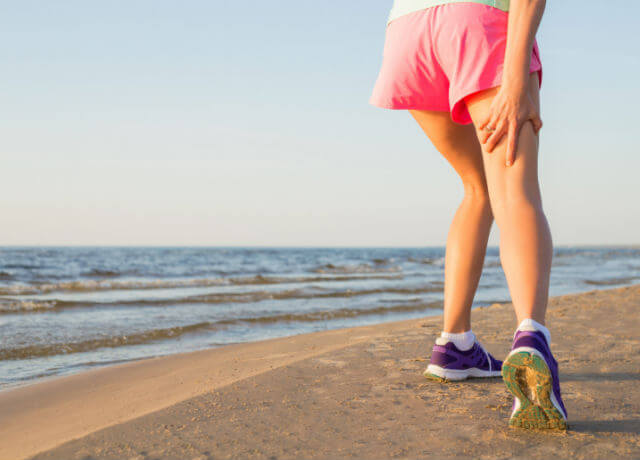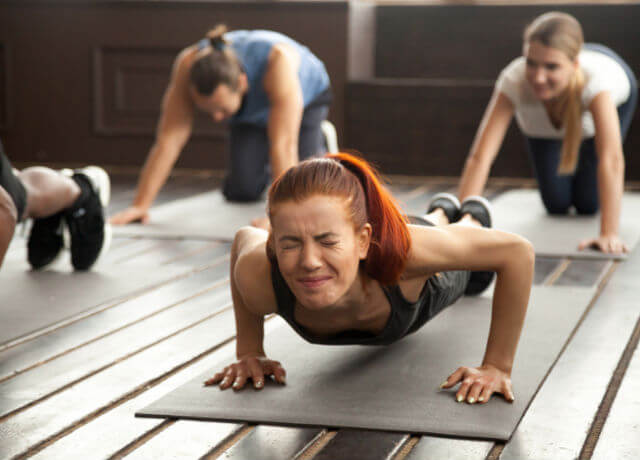Most Common Workout Injuries And How To Prevent Them

A common question I’ve been asked ever since my first days of being a personal trainer is how to prevent workout injuries.
Injuries are painful, annoying, and they can really set you back when you are on a mission to lose weight and tone up. You may find that you are unable to do anything for weeks, and even the smallest tasks can seem difficult like picking up your children or driving your car.
So how can you prevent injury while you are exercising?
Often injuries are caused by not doing an exercise correctly. Other injuries are caused by a lack of strength and overdoing something when your body isn’t ready.
To help you stay safe while you workout, I want to share with you some ways that you can prevent workout injuries.

HOW TO PREVENT WORKOUT INJURIES
Here is a list of some of the most common workout injuries and how you can avoid them while you are working hard to reach your body goals.
1) SPRAINED ANKLE
Spraining your ankle can happen when you walk or run on uneven terrain. If you are doing your cardio outdoors, then make sure to do it where the ground is flat.
This means using footpaths or flat grassy areas where you can clearly see if there are any holes or ridges on the ground.
Supportive shoes will also help prevent sprained ankle injuries. Be sure to find a shoe that is suited to your foot (most stores that sell running and gym shoes will be able to assess your foot and find a shoe that has the right support).
Also be sure to pay extra attention if you are walking or running up and down stairs.

2) RUNNER’S KNEE (PATELLOFEMORAL SYNDROME)
About 40 percent of running injuries are caused by runner’s knee. It’s a condition that becomes worse from walking down stairs, sitting with bent knees, or running. It can be painful, and you may experience creaking or crunching sounds in your knee.
This irritation of the kneecap cartilage can actually be improved by strengthening your quad, glute, and hip flexors. You can also try shortening your stride and talking shorter steps as well as avoiding kneeling or squatting.
3) STRAINED BACK
While this is more common for people that lift weights a strained back can happen even if you are not working out. One of the major non-gym related causes is lifting something heavy like a box or piece of furniture and using your back rather than your legs to carry the weight.
You can strengthen your back muscles by doing some low intensity exercises, and always remember to bend your knees and keep your back straight when you need to lift something.

4) STRESS FRACTURES
Tiny hairline fractures, otherwise known as stress fractures, are sometimes found in your feet. These can be a result of repetitive jumping. But they can also occur when you do too much too soon, and your feet can’t handle the extra pressure.
The best way to avoid them is by slowly increasing your exercise volume each week, by no more than 5-10%.
If you run 5 kms at a time this week, don’t do any more than 5.5 kms next week.

5) ITBS (ILIOTIBIAL BAND SYNDROME)
The IT band is a ligament that runs from your hip to your shin along the outside of your thigh. ITBS is common for cyclists when their seat height is not set appropriately. It also occurs in runners too. If you want to know how to prevent workout injuries while running you should:
- Do a short walk as a warmup before you start running
- Replace worn out shoes when needed
- Avoid running on concrete – try to run on grass if possible
- Change directions often – recommended if you use a running track
RELATED POST: HOW TO LIFT WEIGHTS WITHOUT GETTING BULKY
6) PULLED OR TORN HAMSTRING
Hamstring injuries are caused by weak or imbalanced leg muscles. If you have a hamstring injury, you will usually have to miss out on most forms of exercise for a while they heel.
In order to prevent them from happening, you should concentrate on strengthening all of your leg muscles. You should also make sure that you do a proper warm up and appropriate stretching before your workout.

OTHER TIPS ON HOW TO AVOID WORKOUT INJURIES
Here are some other general tips on how to prevent workout injuries:
- Build your strength slowly. When your muscles are weak. It’s easy to get injuries when you push yourself too far. Building muscle strength all over your body is important in preventing injuries.
- If something doesn’t feel right, then it most likely isn’t. Do what you feel comfortable with. Your body shouldn’t be hurting from doing regular exercise.
- Just because you see bodybuilders at the gym looking like they are going to pop an eyeball out while they are lifting, doesn’t mean you should be!

- Perfecting your technique is the best way to prevent workout injuries. If you aren’t sure how to do an exercise correctly, make sure you ask a personal trainer. Doing exercises in the wrong way can do more harm than good. Good form is extremely important.
- When working out at home, use a mirror so you can see if you are doing the exercise correctly.
- Drink water and keep your body hydrated throughout the day. When working your muscles, it’s a good idea to drink something with electrolytes.

- Know your trouble areas and find ways to improve the strength in those muscles and surrounding areas.
- Ensure that you do the appropriate warm ups and stretching for your workouts. Warming up will help improve your mobility and prevent injury, while stretching helps your muscles recover
- Mix up your exercise and workout routines so that you are doing different things. Sometimes repeating the same muscle movements over and over can cause problems like shin splints or tendinitis.
- If you feel dizzy or physically sick, stop what you are doing right away!
- Have rest days! While you may think that you need to exercise every day to be able to reach your body goals, your body needs time to recover. Have at least 1 or 2 days off per week to rest.

Read these tips on how to get rid of muscle soreness after a workout.
RETURNING TO EXERCISE AFTER INJURY
If you do happen to get an injury, it’s important not to repeat the activity that caused the injury until you are fully healed. Otherwise you will put stress on the injury and may make it worse.
You can still keep active though, and you may find that you heal quicker if you are still doing some form of exercise. If your injury lasts more than 3 days, be sure to get it checked out by a professional.

EVERY WORKOUT COUNTS
Injuries happen, but if exercise correctly and don’t do more than your body can handle, injuries are rare. I personally have never had a workout injury.
Remember not to push yourself and do more than your body can handle. As I talk about in my 3 Steps to L
As long as you are doing something and increasing your reps or cardio over the course of a few weeks then you’re doing great! You’ll notice your strength increasing and you’ll be doing fantastic in no time.
Take care and stay safe!
Love Rachael Xx







Hi Rachael
I am currently on week 2 of the mesomorph program, and am loving it so far.
I have not done the running though, as I really hate it and I have mild scoliosis so I am not meant to run in any case. I have been substituting the 30min runs for 45min power walks – is that a good enough substitution or should the walk be longer to compensate?
I have also noticed that due to the scoliosis, my left hip is ever so slightly higher than my right hip, so my right leg feels longer than my left. After the power walks I have felt as though the muscles in my right leg are more sore than the left. Is there any possibility that one leg will end up bigger/smaller than the other with the amount of power walking I am doing? I measured them and they are both the same right now.
All the advice I have been given for scoliosis, is to do core strengthening exercises so the one side doesn’t keep on overcompensating for the other. There is quite a lot of core work in your program so I am hoping that this is enough to help.
I would love your advice on the above if you have ever encountered anything like this with others on your program :)
Thanks so much for creating this – I can’t wait to send the before and after pics in 6 week’s time :)
Hi lovely,
I’m so happy to hear you’ve been enjoying the program! :) Yes, walking is even better than running for slimming down the legs, so you will still get results (walking is the best substitute for running).
The best way to fix uneven sides of your body is to do unilateral exercises (training one side of your body at a time, so you can use them equally).
Most of the leg workouts in our Lean Legs Program are unilateral, so make sure that you’re doing the same number of sets and repetitions for each leg and try to keep the mind-muscle connection while performing these exercises. Power walking doesn’t build muscle, so it won’t affect the size of your thighs.
Wishing you all the best! xx
Love,
Diana
Hi Rachael! I love rowing (Concept 2). I already have too muscular thighs but also extra fat on them. If I row on low resistance and concentrate on my back and arms, an it reduce my muscle? It’s essentially no weight but repetitive motion. Thanks!
Hi lovely,
If your thighs get bulky easily I wouldn’t do rowing too often. It’s a great cardio workout, but it relies heavily on your quads. If you focus only on your upper body, it could be a good option.
For more helpful tips please have a read of this blog post:
https://www.rachaelattard.com/cycling-dancing-barre-make-legs-bigger/
Love,
Diana
xx
I was wondering should you work out if you have a cold or sinus infection? I have been told yes and no.
Hi lovely,
That depends on how you’re feeling in general. If you’re unable to breathe properly and you’re feeling less strong, then it’s best to take some time to recover. If you feel like you can work out normally, then there’s no reason not to. Wishing you a speedy recovery! :) xx
Love,
Diana